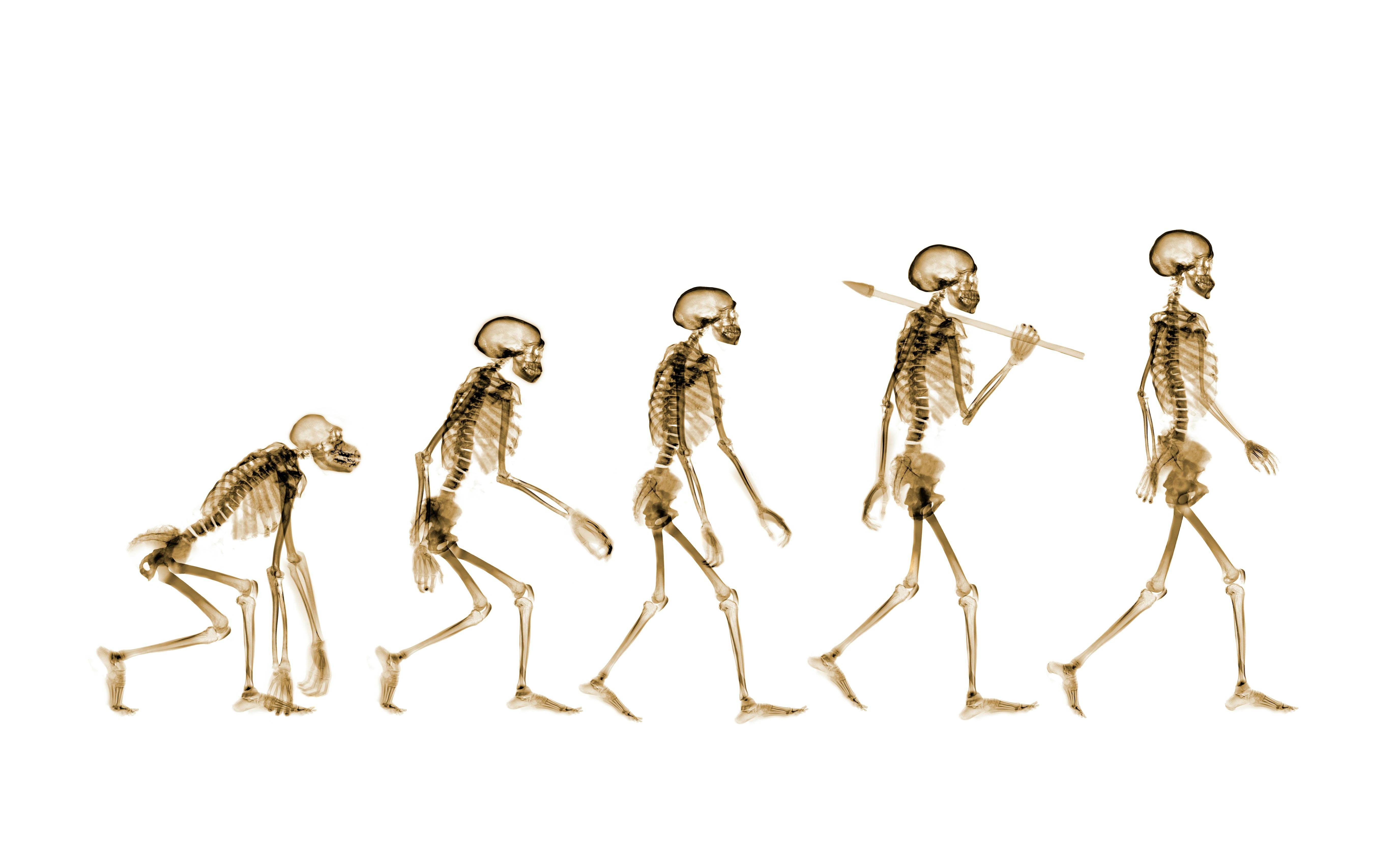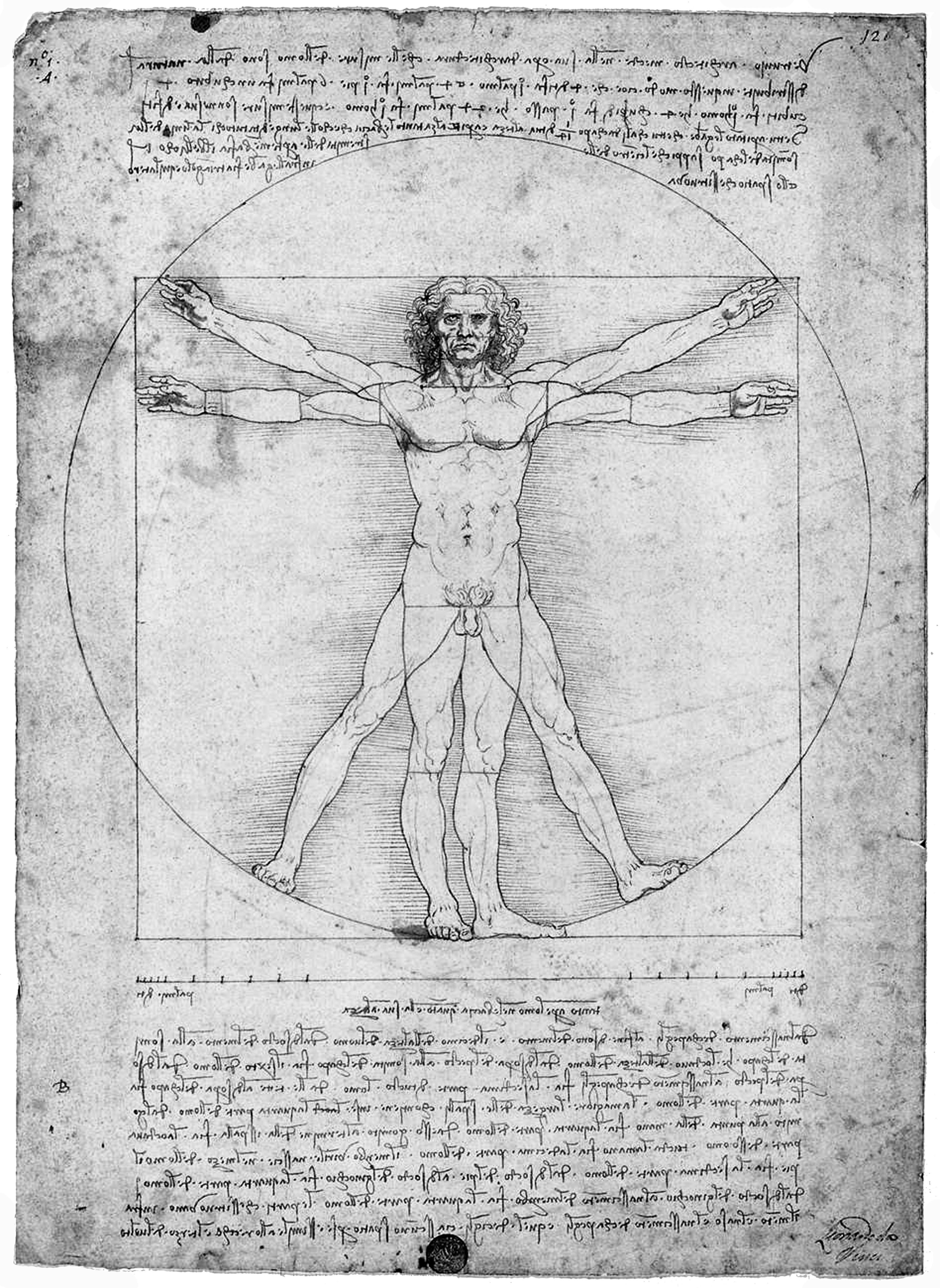
You will be hard-pressed to find an animal that has no rudimentary or useless traits: Atrophied eyes, discarded wings, or male breasts, to name just a few of many.
These are all signs of history, legacies of distant relatives, disused structures that evolution will tolerate for a while or will reuse at a later date should they be needed, as in the case of the eyes that can be found below the skin of some moles, or penguin wings used as fins, or insect wings that are repurposed as halteres. From the nucleus of each cell to the architecture of our organs, the human body, too, bears the traces and wounds of a long and contrasting evolutionary history. Naturally, not everything in our bodies serves a purpose; otherwise, we would have to ask ourselves why we (and not the Neanderthals) have chins. To look for a function at all costs would be ridiculous. Indeed, despite the fact that the beautiful proportions of da Vinci’s Vitruvian Man are inscribed within a circle and square, our physique is mainly a compendium of mismatches worthy of Homer Simpson.
A biological oddity

In males, for example, what is the point of the urethra passing right through the center of the prostate, whose function is in no way linked to urination? The result is that when the latter becomes inflamed and enlarged over the years, there is a lot of unnecessary pain. This makes absolutely no sense other than the fact that until recently, people did not grow old enough to suffer from such an ailment. It makes no sense, but this is evolution. Imperfection in nature arises from the need to find compromises between different needs and antagonistic selective drives. This means that an advantageous trait can evolve and succeed despite the fact that its owners pay the price in the form of annoying side effects.
The appendix is another good case in point. While recent studies suggest it may have some secondary advantages related to the immune system or could act as a reservoir of good bacteria in case of infections, there were numerous potential anatomical solutions that would have been more efficient and less painful than this one. Today, when needed, we can get by through an emergency operation, but to have a wormlike appendix in our bellies is decidedly a bad idea.
Another such example is the external scrotum. Many mammals have one, including us, and we know that it plays an important role in cooling the testicles for the production of spermatozoa. Nonetheless, many mammals — including elephants, hyraxes, anteaters, dugongs, elephant shrews, and golden moles — have testicles inside their bodies, where they’re far less vulnerable. Thus the external scrotum is useful but not essential.
Concealed ovulation is yet another oddity that we have almost uniquely. Human males do not perceive the moment when females are ready to conceive. In the more reasonable baboons, mandrills, chimpanzees, and bonobos, the female in estrus is recognizable due to the appearance, turgidity, and coloration of her genitals and the emanation of specific odors. This means that even the most obtuse male will sooner or later understand when it is time to do his duty, while in the human species, this does not happen. For us and a few other species, such as the gray langur of Southeast Asia, ovulation is concealed. This all goes to produce a great sense of insecurity in the males, who do not know if their copulation, which is often obtained at a high price, has been successful or not.
The list of evolutionary oddities goes on and on. If you can move your auricula like elephants, it means you have useless but still-functioning muscles in your ears. The caudal vertebrae that are fused together under the pelvis are, in fact, the remnants of your tail, and the coccyx still serves as a point of attachment for some muscles. Just ask the opinion of anyone who has fallen down the stairs and violently hit the edge of a step. Those who suffer from debilitating back pain understand well the imperfections of human bipedalism, a compendium of locomotor inefficiency that made us human. For a moment, let us consider our strange posture, perhaps the most imperfect of our adaptations.
The Most Imperfect of Revolutions: Walking

The human spine did not evolve out of thin air. The supple spine of a quadruped or brachiator (the preexisting constraint and evolutionary inertia) was straightened out, meaning that the weight of the whole body now rests on a single axis and offloads on the two legs. As a result, the spine is curved, and the vertebrae are subjected to undue pressure. Nerves and muscles have readjusted themselves as far as possible, but not enough to prevent sciatica, hernias, and flat feet. If, after all that effort made to stand upright on its lower limbs, that biped spends all of its days sitting at a desk or in a car, however, we are actively in search of the pain of imperfection.
So why become bipedal? This question is actually more difficult than it sounds. The upright posture is said to have enabled long-distance running and greater flexibility in locomotion. A quadruped will destroy us over a hundred yards, but we perform well as cross-country runners. As bipeds, we can climb if necessary, as well as walk, run, and ford a river. This may well be true, but the fact remains that in the open spaces of the savanna, the other animals are almost all quadrupeds, and so far, they have coped quite well. It has also been said that bipedalism offered our ancestors the possibility of showing themselves to predators as a vertical rather than horizontal silhouette (much more visible to the average feline) and of standing above the grass to better spot predators at a distance. And then, of course, an upright posture freed our hands and arms from locomotion so they could be used to manipulate tools as well as carry food and the young. But did we become bipeds to free our hands, or did our hands become free because we became bipeds?
Alas, the numbers do not add up because the first lithic technologies appeared in Africa as far back as 3.3 million years ago when there were still 700,000 years to go before the arrival of the genus Homo, and as far as we know, only the australopithecines and Kenyanthropus with their many arboreal traits were still roaming around Lake Turkana. Why did technologies come first and then total bipedalism? What is the cause, and what is the consequence? Remembering, of course, that the bipedal gait costs us all of those expensive imperfections listed above, it must have been worth it right from the start, as otherwise, our more arboreal counterparts would have prevailed.
Other experts in human evolution maintain that the initial push toward bipedalism was linked to thermoregulation. When species that live in zones bordering between forest and grassland explore open sunny areas with no shade, they have a serious problem regarding the maintenance of body temperature within certain physiological limits, and this applies particularly to the brain, which does not tolerate overheating well. Savanna quadrupeds have developed appropriate countermeasures that are lacking in hominins like us. The solution adopted by our tribe appears to have been the reduction of surface area exposed to the sun to ensure that our body temperature was kept under control. At the same time, our ancestors may have gradually lost their fur and developed sweat glands. If this is the case, a thermoregulatory adaptation could then have triggered the cascade of advantageous uses (flexible locomotion and the liberation of the upper limbs, for example) that made bipedalism a good strategy despite its costs.
It is also likely that, due to these compromises, and despite its undoubted merits, bipedalism evolved slowly and timidly over a period of four million years, following several failed attempts and unsuccessful experiments.
One such example is Ardipithecus, which was a forest biped that walked along branches. For two-thirds of the natural history of hominins (six to two million years ago), our ancestors, cousins, and relatives rightly preferred a hybrid solution: an arboreal life so they could protect themselves from predators (with persistent ancient traits such as curved fingers and long arms) and the prudent bipedal exploration of open glades in search of food. Lucy lived in this way and died when she fell out of a tree. This was by far the most intelligent strategy at the time for those that were yet to become brave hunters but were delicious prey for felines and giant eagles. Today, baboons and many other primates do the same. So let us forget the story of human evolution that begins with the heroic “descent from the trees” to conquer the savanna on foot. Only in the early days of the genus Homo did we become complete bipeds.
And many of our companions still curse that day. Walking upright on your legs becomes a big risk if your diet changes in the meantime, your brain starts to grow, and you have to give birth. The pelvis cannot expand much because if it did, you would not be able to stand upright. Consequently, the baby’s head passes with considerable difficulty. If you could reset and go back, the ideal engineering solution would be to give birth directly from the abdomen, but this is not possible because our birth canal is a modified version of that of reptiles, which lay eggs, and of early mammals, which give birth to tiny offspring via the pelvis. So compromises are improvised, fixing pregnancy at nine months and giving birth to helpless babies whose brains are only one-third developed, with the remaining two-thirds being completed later. It remains a truly imperfect solution, however, if we think not only of how many mothers and babies have died during childbirth but of how painful it is for women at the best of times.
The transition to bipedalism generated negative consequences in almost every part of the body. Human feet, with their plantigrade locomotion, have to tolerate high-stress levels. Our neck, with that heavy, swinging bowling ball balanced on top, becomes a weak point. The abdomen, with all of its internal organs, is exposed to all sorts of trauma. The peritoneum is being pushed down by the force of gravity, provoking a predisposition to hernias and prolapses. You might even feel the consequences on your face. The next time you have a cold and feel the mucus pressing into every orifice of your face, think about the fact that your constipated maxillary sinuses have their drainage channels pointing upward toward the nasal cavities — against gravity! This makes them completely inefficient and easily clogged up with mucus as well as other slimy substances. This seems like a bad design, but the fact is that in a quadruped, the opening of the maxillary sinuses faces forward, which works well. Yet, for former quadrupeds like us, our faces have only recently adopted a vertical position, and this is the result.
Archaeologist André Leroi-Gourhan was right in saying that the history of humanity began with good feet before great brains. But it was an ordeal, particularly in the beginning. Then we grew to like it, and with those legs, we became migrant primates with a strong sense of curiosity and no more boundaries to hold us back.
This article was originally published on The MIT Reader by Telmo Pievani. Read the original article here.







